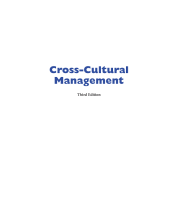Summary: Cross-Cultural Management Essential Concepts | 9781483315232 | David C Thomas, et al
- This + 400k other summaries
- A unique study and practice tool
- Never study anything twice again
- Get the grades you hope for
- 100% sure, 100% understanding
Read the summary and the most important questions on Cross-Cultural Management Essential Concepts | 9781483315232 | David C. Thomas; Mark F. Peterson
-
1 Introduction
This is a preview. There are 1 more flashcards available for chapter 1
Show more cards here -
categories of change that illustrate the process of globalization:
1. growing economic interconnectedness
2. more complex and dynamic work environment
3. increased use and sophistication of information technology
4. more and different players on the global stage -
types on international management research:
- domestic research >single country, no cultural orientation of country)
- replication research > one country, repeated in other countries, responses compared
- indigenous research > varied ways of managers, cultural differences within a single country
- comparative research > both similarities and differences, more than one cultural perspectives across cultures
- international research > MNE's, both similarities and differences but cultural context is not present!
- intercultural research > interactions between culturally different individuals in org settings
-
2 Describing culture - the basics
This is a preview. There are 4 more flashcards available for chapter 2
Show more cards here -
reasons why culture differ: other factors -
climate, topography, economic systems, technology, political boundaries -
3 A comparison of cultures
This is a preview. There are 5 more flashcards available for chapter 3
Show more cards here -
Kluckhohn and Strodtbeck identified six dimensions
1. relationship to nature (subjugation, domination, harmony)
2. relationship between people (individualistic/collectivistic)
3, believes about human nature (good/evil)
4. nature of human activity (achieving, doing, being)
5. orientation to time 9pas, present, future)
6. conception of space (public vs private) -
mistake of applying the scores at country level to individuals
ecological fallacy -
the schwartz value survey
conducted a series of studies on the content and structure of human values -
svs identified three universal human requirements
1. the nature of the relationship between the individul and the group
2. preservation of the society itself
3. final problem related to the relationship of people to the natural world -
seven value types of cultural dimension at the level of national culture
1. egalitarianism: recoginition of people as moral equals
2. harmony: fitting in with the environment
3. embeddedness: people as embedded in the collective
4. hierarchy: legitimation of unequal distribution of power
5. mastery: exploitation of the natural/social environment
6. affective autonomy: pursuit of positive experiences
7. intellectual autonomy: independent pursuit of own ideas -
Hofstede- positive relation between..
.. gross national product and individualism -
5 cross-cultural decision making of management
This is a preview. There are 4 more flashcards available for chapter 5
Show more cards here -
cultural variation in decision criteria
1. amount of information
2. differences in past and future oriented cultures
3. vary in choice rules (individualistic/collectivistic)
4. motivational differences
5. who/how long
- Higher grades + faster learning
- Never study anything twice
- 100% sure, 100% understanding
































